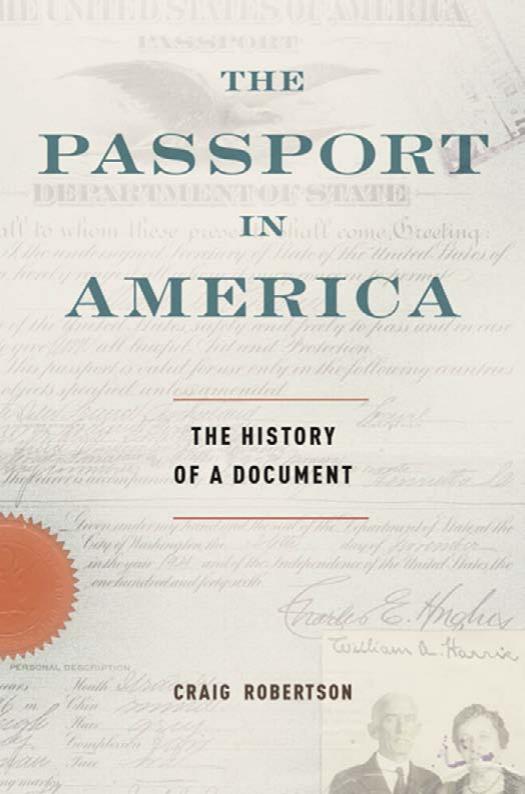The Passport in America: The History of a Document by Craig Robertson

Author:Craig Robertson [Robertson, Craig]
Language: eng
Format: epub, pdf
Tags: Law, Emigration & Immigration, Legal History
ISBN: 9780199927579
Google: cG5MoS928GYC
Amazon: 019992757X
Publisher: Oxford University Press
Published: 2010-06-03T08:00:00+00:00
The doubt U.S. border officials felt toward identification documents also included the U.S. passport. A passport was challenged on the grounds of its uncertain legal authority at the U.S. border and the lack of belief that it could accurately identify an individual. This was the source of a dispute between the State Department, which issued passports, and the Department of Commerce and Labor, which had the responsibility of enforcing immigration regulations. The attempts of some Chinese to enter the country as U.S. citizens initiated the first significant debate between the two departments about the U.S. passport. A second case centered on the need for naturalized citizens to identify themselves after the Immigration Bureau introduced a requirement that steamship companies provide a manifest of citizens as well as aliens.
Although Chinese could not be naturalized, the Supreme Court clarified the status of Chinese born in the United States when it recognized Chinese birthright citizenship in 1898.73 Soon after the decision, the State Department began to forward all Chinese applications for passports to the immigration officials in the Treasury Department, in recognition of an assumed expertise in dealing with Chinese. When the newly formed Department of Commerce and Labor took control of Chinese exclusion, it discontinued this practice on the grounds that its Immigration Bureau budget did not contain an appropriation for it, and more significantly, on the belief that immigration officials could legally determine citizenship only in regards to reentry, not evaluate the initial fact of citizenship.74 However, in an effort to maintain authority at the border, immigration officials required that passports issued to Chinese carry a disclaimer that they did not guarantee entry to the United States. This ended two years later when, in 1905, recently appointed Secretary of State Elihu Root had this “unseemly” notation removed. Root refused to accept that passports issued under his authorization should be “discredited by the officers of another Executive department.”75
In response, Victor Metcalf, the secretary of commerce and labor, justified the continued nonacceptance of U.S. passports on the grounds that the document merely offered prima facie evidence of citizenship, and had no legal authority at the U.S. border. He contended that the only legal outline of a U.S. passport’s function, the 1835 Supreme Court case, not only declared it prima facie evidence of citizenship, but also indicated that a passport granted a status to a traveler abroad as an act of courtesy. Metcalf used this case to argue that passports were accepted out of convention, not law, and, further, that no legislation indicated that the U.S. passport had any role at home, along the U.S. border.76 In the case of Chinese arrivals, Bureau of Immigration officials specifically doubted the authenticity of U.S. passports, reiterating the belief that Chinese possessed an inherent disposition to dishonest behavior. Therefore, along with the removal of the notation, immigration officials explained their refusal to accept passports as proof of citizenship from Chinese on the grounds that they “contain no certain means of identification and are easily transferred from hand to hand.
Download
The Passport in America: The History of a Document by Craig Robertson.pdf
This site does not store any files on its server. We only index and link to content provided by other sites. Please contact the content providers to delete copyright contents if any and email us, we'll remove relevant links or contents immediately.
| Africa | Americas |
| Arctic & Antarctica | Asia |
| Australia & Oceania | Europe |
| Middle East | Russia |
| United States | World |
| Ancient Civilizations | Military |
| Historical Study & Educational Resources |
Cat's cradle by Kurt Vonnegut(14768)
Pimp by Iceberg Slim(13787)
Underground: A Human History of the Worlds Beneath Our Feet by Will Hunt(11842)
4 3 2 1: A Novel by Paul Auster(11800)
The Radium Girls by Kate Moore(11626)
Wiseguy by Nicholas Pileggi(5323)
American History Stories, Volume III (Yesterday's Classics) by Pratt Mara L(5139)
Perfect Rhythm by Jae(5076)
The Fire Next Time by James Baldwin(5024)
Paper Towns by Green John(4805)
Pale Blue Dot by Carl Sagan(4626)
A Higher Loyalty: Truth, Lies, and Leadership by James Comey(4556)
The Mayflower and the Pilgrims' New World by Nathaniel Philbrick(4285)
The Doomsday Machine by Daniel Ellsberg(4250)
Killers of the Flower Moon: The Osage Murders and the Birth of the FBI by David Grann(4192)
Too Much and Not the Mood by Durga Chew-Bose(4097)
The Sympathizer by Viet Thanh Nguyen(4096)
The Borden Murders by Sarah Miller(4025)
Sticky Fingers by Joe Hagan(3916)
